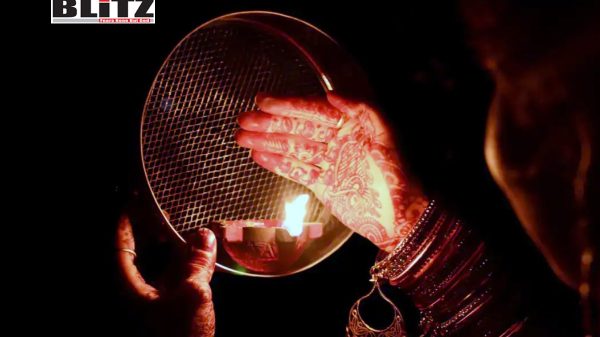Spiritual not submissive: The essence of Karwa Chauth
- Update Time : Sunday, October 12, 2025

The Karwa Chauth fast begins at sunrise with the worship of Lord Ganesha, as it falls on a Chaturthi, and concludes at sunset with the offering of arghya to the Kartik Chaturthi Moon, symbolizing the divine father-son duo, Shiva and Ganesha
Kartik (November) month holds immense spiritual significance in Hinduism, marked by rituals like worship, fasting, pilgrimages, holy baths, and lighting lamps, believed to bring health, prosperity, and divine blessings. Several major mythological events occurred in this sacred month—such as Lord Kartikeya’s slaying of Tarakasura, Lord Ram’s victory over Ravana, Lord Krishna’s destruction of Bhaumasura, and Goddess Lakshmi’s emergence during the Samudra Manthan. The Chaturthi of Krishna Paksha in Kartik is observed as Karwa Chauth, a fast mentioned in the Narada Purana for marital bliss. It is predominantly observed by married women across India—known as Atla Taddi in South India and Gauri Tritiya or Kaan Chauth in Jammu & Kashmir—signifying deep-rooted cultural and spiritual traditions.
The origin of Karwa Chauth is found in ancient scriptures.
Vratotsav Chandrika (8.1, p. 234, Bharat Dharma Press) mentions that when Arjuna went to Kilgiri mountain for penance, a worried Draupadi was advised by Lord Krishna to observe this fast. She did so, and Arjuna returned safely.
2.Another legend from the Shiv-Parvati dialogue narrates that in Satyuga, young Ganesha, obeying Parvati, stopped Lord Shiva from entering her chamber. Unaware of Ganesha’s identity, Shiva beheaded him in anger, and the severed head fell on the moon. Grief-stricken, Parvati gave up food and water. Later, Shiva revived Ganesha and made him the foremost deity of worship. Since then, Kartik Krishna Chaturthi—Karwa Chauth—became the day to worship the moon as a symbol of both Shiva and Ganesha. The moon, representing beauty, attraction, and mental steadiness, is offered arghya through a karwa (earthen pot) after a day-long nirjala (waterless) fast by women praying for their husband’s longevity and marital harmony.
- According to the Sabha Parva of the Mahabharata, a Brahmani named Veeravati also observed the Karwa Chauth fast for her husband’s well-being, highlighting the ancient roots of this tradition.
- The Narada Purana explicitly mentions that the Krishna Paksha Chaturthi of Kartik (November) month is designated for Saubhagyavati women (married women blessed with marital bliss). On this day, women bathe, adorn themselves with beautiful clothes and jewelry, worship Lord Ganesha, and offer ten karwas (earthen pots) as part of the ritual. The fast is concluded after offering arghya to the moon.
- Further scriptural references to Karaka Chaturthi are found in Nirnaya Sindhu and Dharma Sindhu, which state:
“Kartik Krishna Chaturthi is Karaka Chaturthi.
“It must be observed when it coincides with moonrise. If it spans two days, the one with moonrise is considered Sankashti Chaturthi.”
— Nirnaya Sindhu
(कार्तिककृष्णचतुर्थी करकचतुर्थी। स चन्द्रोदय व्यापिनी ग्राह्या। दिनद्वये तदव्याप्त्यादौ संकष्टचतुर्थी व निर्णय: – निर्णयसिन्धुः)
Refuting patriarchal misconceptions: Karwa chauth and the equality of women
Karwa Chauth is an ancient and revered Hindu festival, observed with devotion by married women for the longevity and well-being of their husbands. Far from being a symbol of patriarchy, it represents a woman’s deep spiritual commitment and dedication to her family. Associating this sacred observance with patriarchal oppression is a misinterpretation, as Hindu scriptures have always upheld the dignity and equality of women. Terms like Ardhangini (equal half) and Vamangi (respected companion) emphasize that men and women are complementary partners in life.
The Manusmriti (3.56) affirms:
“Yatra naryastu pujyante ramante tatra devatah”
“Where women are honored, there the gods dwell.”
This verse alone establishes the high status of women in Sanatan Dharma, underscoring that respect for women is foundational to a divine society. (यत्र नार्यस्तु पूज्यन्ते रमन्ते तत्र देवताः” – मनुस्मृति;3.56)
Scriptural affirmation of women’s equality in Hinduism
Hindu scriptures have consistently upheld the dignity, equality, and complementary role of women. A wife is referred to as “Ardhangini”—literally meaning “half of the body”—signifying that man and woman are equals, two halves of one whole. This profound concept is beautifully symbolized in Ardhanarishwara, the divine form of Lord Shiva, where half of his being is embodied as Goddess Parvati.
Another term used is “Vamangi”, meaning “the one who occupies the left side.” In Vedic thought, the left side of the body is considered sacred and close to the heart, making it a powerful symbol of equality and reverence. What greater testimony to gender parity could exist than placing woman at the heart of man?
In the Mahabharata, the character of Draupadi stands as a symbol of strength and dignity. She fought for her honor and played a pivotal role in the great war, proving that scriptures grant women both respect and agency.
Similarly, in the Ramayana, Sita is portrayed as the ideal wife and mother. She chose to accompany Lord Rama into exile, bore every hardship with grace, and when abducted by Ravana, Lord Rama waged an epic battle to rescue her—affirming the immeasurable value and honor accorded to women in our sacred texts.
Not only that, India is a land where kings proudly name their daughters after their own names or kingdoms—reflecting deep respect and legacy. For example, King Janak of Janakpur named his daughter Janaki (Sita); King Drupad’s daughter was Draupadi, while his son was Shakuni. Similarly, Princess Kaikeyi was the daughter of King Kaikeya.
India is also unique in revering maternal identity—sons are often known by their mother’s name: Anjani Putra Hanuman, Devaki Nandan Krishna, Kaushalya Nandan Ram, and many more. This reflects the cultural reverence for motherhood and feminine identity in our tradition.
Above all, there is no scriptural mandate in Hindu texts requiring women to fast for their husbands, look at them through a sieve, or break their fast only after sipping water from their hands. These customs are later additions—popularized through movies and modern storytelling, with no basis in original scriptures. They are myths, not mandates, far removed from the truth of Sanatan Dharma.
The Karwa Chauth fast begins at sunrise with the worship of Lord Ganesha, as it falls on a Chaturthi, and concludes at sunset with the offering of arghya to the Kartik Chaturthi Moon, symbolizing the divine father-son duo, Shiva and Ganesha. Shiva, the god of Kaal (time), blesses fasting women’s husbands with protection and longevity through this vrat. Lord Ganesha is worshipped on 24 Chaturthi days annually, including Sankashti Chaturthi (fourth day after Purnima) and Vinayaka Chaturthi (fourth day after Amavasya). The Kartik Maas Krishna Paksha Chaturthi, or Karak Chaturthi, is especially significant for strengthening marital bonds.
Unlike typical Hindu fasts that last 24 hours, this vrat ends at sunset, reflecting spiritual health principles rooted in ancient scriptures and scientific wisdom. Despite its profound cultural and spiritual importance, Karwa Chauth is often misunderstood and mislabeled as patriarchal by uninformed critics, overlooking its true essence as a celebration of devotion, protection, and marital harmony.
The Karwa Chauth fast transcends mere ritual; it embodies the virtues of wifely devotion, faith, and inner strength. Rather than viewing it through a patriarchal lens, it should be celebrated as a testament to a woman’s empowerment and unwavering dedication. More than just a symbol of sacred marital devotion, Karwa Chauth is a deeply spiritual tradition that connects devotees with Lord Ganesha and the cosmic divine energies. This festival offers profound insight into traditional values, inspiring us to embrace and integrate these timeless principles into our lives with reverence and purpose.














